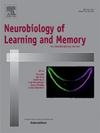The interval between conditional stimulus onset and unconditional stimulus onset, not training-to-test interval, determines patterns of immediate early gene expression in the anterior retrosplenial cortex
IF 1.8
4区 心理学
Q3 BEHAVIORAL SCIENCES
引用次数: 0
Abstract
Prior work has found that the retrosplenial cortex (RSC) is necessary for formation and retrieval of trace, but not delay, fear conditioning. However, more recently, others have demonstrated that activity in the retrosplenial cortex is necessary for retrieval of a remotely-acquired delay fear memory, suggesting that as memory undergoes systems consolidation it becomes more dependent on neural activity in the RSC. Here, we aimed to examine expression of the immediate early gene zif268 in two distinct subregions of the retrosplenial cortex (anterior and posterior) following retrieval of either a recently-acquired or remotely-acquired delay fear memory. We found that while presenting the conditional stimulus either 1 day or 30 days following delay fear conditioning produced strong conditional responding, activity in either the anterior or posterior RSC assessed through expression of the immediate early gene zif268 was not elevated in the remote retrieval group, contrary to our hypothesis. Instead, activity in the pRSC was elevated in the group that received conditioning the day before. In line with some of our prior work, this suggests that animals in that group were showing neural activity in response to placement in a novel context. We then aimed to determine the circumstances under which delay fear retrieval could produce changes in the anterior RSC, which has been associated with conditional stimulus (CS) encoding and retrieval in a trace fear paradigm. We therefore compared delay and trace conditions to a delay conditioning procedure in which the CS and unconditional stimulus (US) onsets were matched to that of the trace procedure. We found that while both the trace and long-cue delay groups showed a similar behavioral pattern, with freezing that gradually extinguished throughout the 10-CS session, freezing in the standard delay group remained high. When examining zif268 activity, we found that while all three groups showed elevated zif268 expression in the pRSC, only the long-cue delay and trace groups showed increased aRSC activity. Interestingly, only the short-cue delay group showed increased zif268 activity in the basolateral amygdala, corresponding with their elevated fear behavior throughout the session. Together, these results suggest that zif268 activity in the RSC following conditioning is related to the interval between CS onset and US onset.
条件刺激开始和无条件刺激开始之间的时间间隔,而不是训练到测试的时间间隔,决定了脾前后皮层的即时早期基因表达模式
先前的研究发现,脾后皮层(RSC)是形成和恢复痕量恐惧条件反射所必需的,而不是延迟恐惧条件反射。然而,最近,其他人已经证明,脾后皮层的活动对于远程获得的延迟恐惧记忆的检索是必要的,这表明随着记忆经历系统巩固,它变得更加依赖于RSC的神经活动。在这里,我们的目的是在最近获得的或远程获得的延迟恐惧记忆恢复后,检测直接早期基因zif268在两个不同的脾后皮层亚区(前部和后部)的表达。我们发现,当延迟恐惧条件反射后1天或30天呈现条件刺激时,会产生强烈的条件反应,通过即时早期基因zif268的表达评估,在远程检索组中,前部或后部RSC的活性均未升高,这与我们的假设相反。相反,在前一天接受条件反射的组中,pRSC的活性升高。与我们之前的一些工作一致,这表明那组动物在对新环境的反应中表现出神经活动。然后,我们旨在确定延迟恐惧检索在何种情况下会产生与条件刺激(CS)编码和检索相关的前侧RSC的变化。因此,我们将延迟条件和跟踪条件与延迟条件过程进行了比较,其中CS和无条件刺激(US)的开始与跟踪过程的开始相匹配。我们发现,虽然线索延迟组和长线索延迟组都表现出类似的行为模式,在10-CS会话中,冻结逐渐消失,但标准延迟组的冻结仍然很高。当检测zif268活性时,我们发现虽然所有三组在pRSC中的zif268表达均升高,但只有长线索延迟组和微量组的aRSC活性升高。有趣的是,只有短提示延迟组显示出杏仁核基底外侧的zif268活性增加,这与他们在整个过程中升高的恐惧行为相对应。总之,这些结果表明,条件反射后RSC中zif268的活性与CS发病和US发病之间的间隔有关。
本文章由计算机程序翻译,如有差异,请以英文原文为准。
求助全文
约1分钟内获得全文
求助全文
来源期刊
CiteScore
5.10
自引率
7.40%
发文量
77
审稿时长
12.6 weeks
期刊介绍:
Neurobiology of Learning and Memory publishes articles examining the neurobiological mechanisms underlying learning and memory at all levels of analysis ranging from molecular biology to synaptic and neural plasticity and behavior. We are especially interested in manuscripts that examine the neural circuits and molecular mechanisms underlying learning, memory and plasticity in both experimental animals and human subjects.

 求助内容:
求助内容: 应助结果提醒方式:
应助结果提醒方式:


